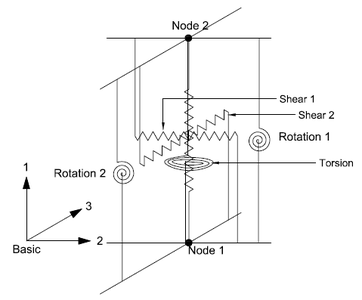HDR
This command is used to construct an HDR bearing element object in three-dimension. The 3D continuum geometry of an high damping rubber bearing is modeled as a 2-node, 12 DOF discrete element. This is the third element in the series of elements developed for analysis of base-isolated structures under extreme loading (others being ElastomericX and LeadRubberX). The major difference between HDR element with ElastomericX is the hysteresis model in shear. The HDR element uses the model proposed by Grant et al. (2004) to capture the shear behavior of a high damping rubber bearing.
The syntax of command to use this element in a 3D problem:
| element ElastomericX $eleTag $Nd1 $Nd2 $qRubber $uh $Gr $Kbulk $D1 $D2 $ts $tr $n $a1 $a2 $a3 $b1 $b2 $b3 $c1 $c2 $c3 $c4 <<$x1 $x2 $x3> $y1 $y2 $y3> <$kc> <$PhiM> <$ac> <$sDratio> <$m> <$cd> <$tc> |
| $eleTag | unique element object tag |
| $Nd1 $Nd2 | end nodes |
| $qRubber | yield strength |
| $uh | yield deformation |
| $Gr | shear modulus of elastomeric bearing |
| $Kbulk | bulk modulus of rubber |
| $D1 | internal diameter |
| $D2 | outer diameter (excluding cover thickness) |
| $ts | single steel shim layer thickness |
| $tr | single rubber layer thickness |
| $n | number of rubber layers |
| $a1 $a2 $a3 $b1 $b2 $b3 $c1 $c2 $c3 $c4 | parameters of Grant model |
| $x1 $x2 $x3 | vector components in global coordinates defining local x-axis (optional) |
| $y1 $y2 $y3 | vector components in global coordinates defining local y-axis (optional) |
| $kc | cavitation parameter (optional, default = 10.0) |
| $PhiM | damage parameter (optional, default = 0.5) |
| $ac | strength reduction parameter (optional, default = 1.0) |
| $sDratio | shear distance from iNode as a fraction of the element length (optional, default = 0.5) |
| $m | element mass (optional, default = 0.0) |
| $cd | viscous damping parameter (optional, default = 0.0) |
| $tc | cover thickness (optional, default = 0.0) |
An example use of this element can be found here: to be updated!
References
- Kumar, M., Whittaker, A., and Constantinou, M. (2014). "An advanced numerical model of elastomeric seismic isolation bearings." Earthquake Engineering & Structural Dynamics, Published online, DOI: 10.1002/eqe.2431. Link
- Grant, D. N., Fenves, G. L., and Whittaker, A. S. (2004). "Bidirectional modeling of high-damping rubber bearings." Journal of Earthquake Engineering, 8(sup001), 161-185.

